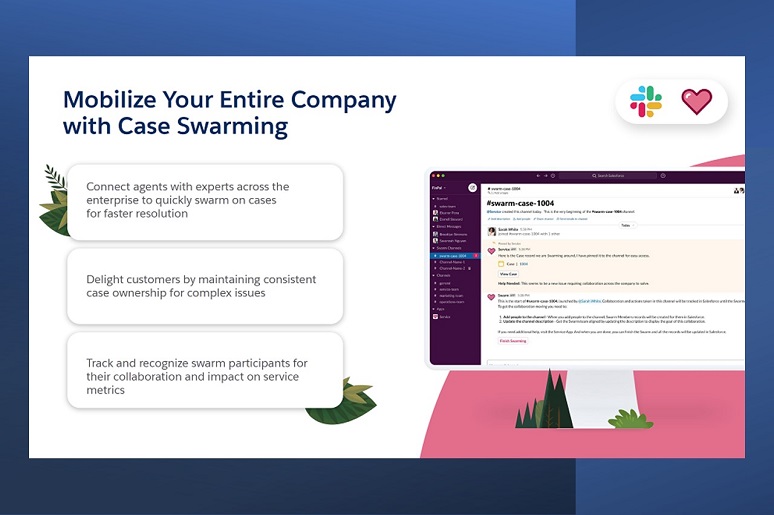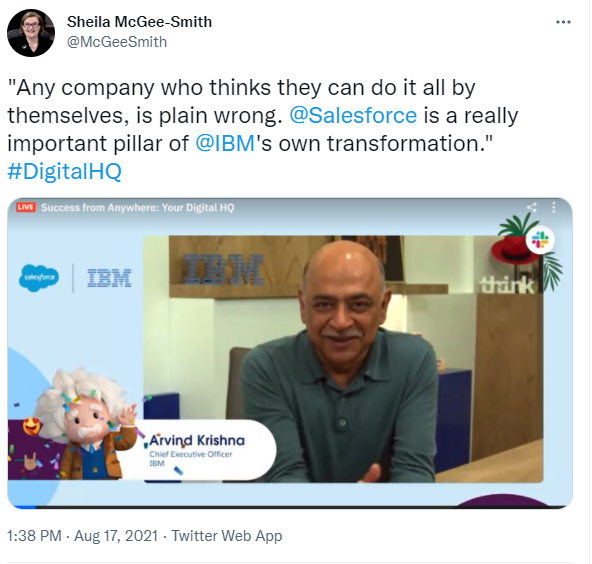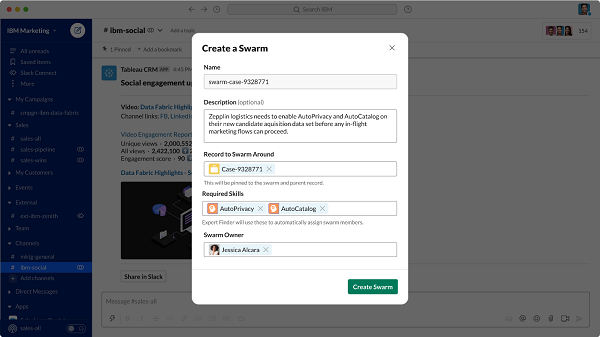Slack has been the topic of many No Jitter posts since its launch in 2013. The first, “
Will Unified Communications be Eaten by Messaging?,” in January 2015, foreshadowed the revolutionary potential of corporate messaging. But as a contact center analyst, I’d penned none of the countless posts on Slack written to date — until now. With Salesforce’s
acquisition of Slack, the worlds of collaboration software and customer experience are coming together in a brand-new way.
How Salesforce plans to use Slack to help reinvent customer service was one of the topics of the one-hour “
Success from Anywhere: Your Digital HQ” event the company hosted on Aug. 17. As seen in the graphic above, Salesforce uses the term “
case swarming” to describe how agents can automatically create a Slack channel to connect agents with experts across the enterprise, with the idea that these quickly formed “swarms” will result in faster resolution for cases.
While there is some instant understanding of what case swarming might mean, with a little research I found it to be a defining tenet of the
Consortium for Service Innovation, of which Salesforce is a member. The organization defines Intelligent Swarming methodology as “removing traditional tiers of support” and, when appropriate, calling on the collective expertise of a “swarm” of experts.
Slack-First Service extends the capabilities of swarming to include the creation of specific channels for cases as well as the easy inclusion of channel members from outside the organization. With the Slack integration in Salesforce, Swarm channels and threads are automatically created (via an out-of-the-box workflow) and the right experts are identified and routed the case swarm invitation based on their skillset, capacity, and availability.
Speaking at the Digital HQ event, Arvind Krishna, chairman and CEO,
IBM, offered high praise for Salesforce, describing it’s importance to IBM as a partner. “Any company who thinks they can do it all by themselves, is plain wrong. Salesforce is a really important pillar of IBM’s own transformation,” he said. I shared this comment, and with thousands of impressions, this was one of my top tweets from the live event.
Sarah Franklin, president and CMO, Salesforce, described how IBM uses Slack in marketing, sales, and, in this quote, for customer service. “They use swarms like this one [see graphic below] to work together and resolve issues faster. Expert Finder identifies the right team members to add a channel based on their skills. No more guesswork, all the necessary and related information like case status metrics, customer details, history, the [service level agreement] and more are all in the swarm.”
The Expert Finder feature Franklin mentioned is the second new Service Cloud capability Salesforce announced during last week’s event. Expert Finder is integrated with existing Service Cloud omnichannel routing capabilities, automatically identifing the right experts to add to a swarm channel based on availability, capacity, and skills.
Considering that 91,000 companies use Slack, as reported by Tamar Yehoshua, chief product officer at Slack, and that over 150,000 companies use Salesforce, you can imagine that the overlap between these two groups is high, and will only increase in the coming months with the new use cases being built. Both Case Swarming and Expert Finder will be available for pilot this fall, with general availability planned with the Salesforce spring release.
The promise of the combination of Salesforce and Slack reminds me of the communications-enabled business process (CEBP) effort that began about 15 years ago. In 2009, Frost & Sullivan industry analyst Melanie Turek
wrote in a No Jitter post that CEBP is closely tied to integration. “If you are embedding communications into business processes, you need to connect two things: the communications application, and the business process automation application,” she said, arguing that professional services would be the key to CEBP for the foreseeable future. As we know, the requirement of professional services has often been a barrier to the adoption of many otherwise useful technologies. Salesforce plus Slack takes CEBP to the next level, truly embedding communications into processes
without professional services.
As powerful as Slack has been in facilitating communications both within and across companies, its combination with Salesforce — embedding the capability into business processes in marketing, sales, and service — fulfills the promise of CEBP and opens up endless possibilities for businesses. As Slack’s Yehoshua described during the Digital HQ event, “Whether it's working across teams and time zones, synchronous or asynchronous, in-person or remote, structured, or informal, Slack brings people and information together in channels.”
The real-time addition of marketing, sales, and service information that comes with Salesforce integration is what will differentiate the Slack of yesterday from the Slack of tomorrow.
Learn more about the merging worlds of collaboration and customer experience this fall at Enterprise Connect 2021. Register now using the code NJAL200 to save $200 off the current rate.













